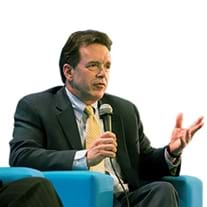Help Wanted to Close the Skills Gap
The fastest growing occupations over the next decade will be in the energy, health and education sectors.
Published October 1, 2019
By Joan Lebow
Academy Contributor

According to the Bureau of Labor Statistics, the fastest growing occupations over the next decade will be in the energy, health and education sectors, while the medical and technical sectors will contain the highest paying occupations. All these occupations will require a STEM education.
STEM learning is often cited by the public and private sectors as the way to prepare for a technology-driven future. A recently published study by Randstad USA, an employment/recruitment agency, found that 68 percent of U.S. workers surveyed would focus on studying science, technology, engineering and math (STEM) fields, if they could restart their educational journeys at age 18.
Spending for STEM education has grown substantially at all levels of schooling, largely due to the investment of billions of public and private sector dollars. This trajectory continues even with the persistent challenge of keeping young people, especially girls, engaged in STEM learning in their elementary years throughout higher education.
Filling the “Skills Gap” in STEM Careers
On the surface, an emphasis on STEM would seem to be all that’s needed to prepare the next generation workforce. But with projections for employment in STEM related occupations expected to grow to more than nine million jobs by 2022 and the steady drumbeat of corporate leaders saying they cannot find qualified workers for millions of open positions, the issues surrounding the so-called “skills gap” are not quite that straightforward.
“To thrive in a digital world, workers will need not only digital skills, but a broad mix of skills including strong cognitive and socio-emotional skills. High level information communication technology skills will also be increasingly important in growing occupations linked to new technologies,” says Fabio Manca, Head of the Skills Analysis team at the Organisation for Economic Co-operation and Development (OECD) Centre for Skills.
The OECD is an international forum and knowledge hub for data and analysis, best-practice sharing, and advice on public policies and global standard-setting. “[Workers] will also need complementary skills, ranging from good literacy and numeracy to the socio-emotional skills required to work collaboratively and flexibly,” says Manca.
Also Developing Soft Skills

Analysts agree that more training and more types of abilities are needed now and in the future for workers to fill those jobs. Along with STEM knowledge, it’s traits like “flexibility” and “adaptability” that analysts repeatedly mention as signposts to success.
“It’s not just the hard skills, but critical thinking and soft skills that will be valued,” says Peter Robinson, president and CEO of the United States Council for International Business (USCIB), a policy advocacy and trade services organization dedicated to promoting open markets and representing American business interests internationally.
Technological advances mean work itself will keep evolving. Robinson and others call for more public-private partnerships among business, education and government to help the labor force prepare for, and respond to change. Without this shared burden they see a skills gap that will only widen.
“You won’t be able to front load your education. You will have to be adaptable to change down the road in your career,” says Robinson.
It Starts with Education
Any one-dimensional academic or on-the-job background, could pose challenges. As the OECD’s 2019 Report on Skills points out, “Initial education systems have a key role to play in providing young people with the skills required for a successful entry into the labor market. However, deep and rapid changes in technology make it difficult for initial education to equip young people with the knowledge and capabilities they will need throughout their work life.”
Says the OECD’s Manca, “Recent research by the OECD also highlights that labor market shortages are widespread in high-skilled occupations that make an intense use of communication and verbal abilities, these latter influencing the acquisition and application of information in problem solving contexts.”
An ability to collaborate, problem solve, think creatively and be malleable enough for a future of life-long learning are essential, experts agree. A paradox is emerging. Such skills are often best learned on the job, and not having them is an impediment to hiring, the USCIB’s Robinson explains. He says companies will need to partner with the education system much earlier. “They can’t just show up on graduation day.”
New approaches to curriculum, modern versions of industrial apprenticeships, and efforts to re-skill existing employees and returning mid-career employees through “returnships” are among the ways to accomplish these expanded training needs. “Employers who want the right work force will also need to invest in training workers,” says Robinson. “But it will not be just about training in computers or robotics. Entire industries may change in ways we don’t foresee.”

Filling the “Investment Gap”
“We have an investment gap,” says Sangheon Lee, Director of the Employment Policy Department of the International Labor Organization (ILO). The ILO seeks to promote full and productive employment by developing integrated employment, development and skills policies. Lee also views reinvigorated job training initiatives as essential to creating a productive workforce.
“The most important thing is to reduce the gap between the rhetoric and investment” Lee says. “In over 20 countries, people are learning more and doing more in STEM. But what they are learning is theoretical and needs to be more reality-based. You need to come out of your education with some reasonable set of skills, and the job would train you further.”
Lee and other labor policy analysts concur, a forward-thinking combination of government, education and industry must support this focus on training and especially life-long learning. For now, employers are poaching skilled workers from other companies.
“They are hesitant to spend money on training for transferable skills, the very skills that are often important to success. Instead, employers typically want to invest only in training related to a specific job, keeping their investments targeted to their bottom line,“ says Lee.
This is especially true in the tech sector where innovative businesses are small and agile, but don’t have the money for significant training programs, Lee notes.
Tax Incentives for Job Training
Neither students nor individuals seeing their jobs morph mid-career can afford to pay for additional training without help. Public incentives will be necessary, from apprenticeships to late-career pivots. According to Lee, new accounting structures, tax incentives for job training, and more up-front government investment will be important tools bridging the skills gap as work changes.
Another critical issue to address that will ultimately narrow the skills gap, Lee says, is gender bias. More attention is needed to improve workplace policies and attitudes towards qualified women in the labor force. STEM skills may land a woman a job, he points out, but attitudes and stereotypes are a persistent barrier to their success especially in STEM professions.
“There is still a lot of implicit discrimination. It’s not just about the ability to do the job,” Lee says.
Labor policy analysts say it’s an over-simplification to divide jobs of the future into tech and non-tech roles; the future of work will be far more nuanced than what works for the STEM haves and have nots. To prepare for what’s ahead and be able to address changes when the time comes, as well as to find a workforce with the necessary skills, will take a longer, collaborative view from many societal sectors.
“There needs to be a paradigm shift, from employment to employability, says Robinson from USCIB.
